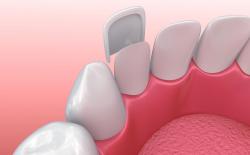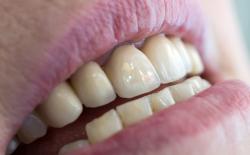What is the E-Max system?
E-Max is a highly esthetic and durable lithium disilicate-based all-ceramic (metal-free) restoration system by Ivoclar Vivadent.
This is probably the most natural-looking material used in restorative dentistry, that's why it is widely used for front teeth restorations.
Since it contains no metal, it's safe to use even if you have a metal allergy or simply don't want to have metal in your mouth.
E-Max is often the material of choice for crowns, veneers, and bridges in the anterior region.
Is an E-Max bridge right for you?
Short span (3 unit) E-Max bridges are widely used in the anterior / premolar region to replace a missing tooth.
Longer E-Max bridges or use in the molar are not recommended, as the material is just not tough enough to withstand the increased forces in these cases. However, some studies show excellent survival rates even for such non-recommended uses.
E-Max can also be supported by zirconia, which makes the restoration strong enough for longer bridges or posterior restorations.
Other things to consider:
- Eating habits: If you like to chew hard foods often (e.g. ice, nuts, chips, carrots, etc.), the E-Max bridge might not be the best choice for you, as it might crack.
- Bruxism: In this case, a more durable restoration (e.g. zirconia bridges) is probably a better choice.
To sum up, if you are not a serious grinder and have one missing tooth in the front, the E-Max bridge is a great choice. In all other cases, you might want to consider other materials, such as zirconia, to ensure the long-term survival of your restoration.
A patient testimonial about E-Max restorations. Duration: 1:47
Advantages of E-Max bridges
- Esthetics: This is the main advantage of all E-Max restorations. E-Max has a natural translucency and looks like your natural teeth.
- Metal-free: Since E-Max bridges are not metallic, they are suitable for people with metal allergies.
- No black line near the gum: The underlying metal of porcelain fused to metal restorations might become visible at the gumline. Since there is no metal in E-Max bridges, this unsightly black line at the gums will not appear.
- Durability: When used properly, E-Max bridges can be very durable, they bond well with the tooth and are not likely to crack or chip.
- Ability to be milled: If your dentist has the appropriate CAD / CAM devices, E-Max bridges can be milled at the dental clinic. This means you can get your new bridge within a few hours, no 5-10 days waiting for the lab, no temporary bridges.
In this short video, a dentist talks about CAD / CAM manufactured E-Max. Duration: 0:38
Disadvantages of E-Max bridges
- High price: E-Max is among the more expensive restorations. Be prepared to pay more, compared to porcelain fused to metal bridges or even zirconia bridges.
- Not recommended for long-span restorations: E-Max is ideal for 3 unit anterior bridges, anything longer than this has a higher chance of cracking.
- Not recommended in the posterior region: While E-Max bridges are highly durable, the lithium disilicate is not as strong as zirconia, so zirconia bridges are preferred for back teeth restorations.
- May not suit darker teeth: Since E-Max is highly translucent, it might look “too natural” if you have darker teeth. In such cases, a zirconia bridge can be a better option.
A case study of a 6-unit upper anterior E-Max bridge (so it's longer than recommended, as mentioned in the video, too). Duration: 5:57
How much does an E-Max bridge cost?
E-Max is probably the most expensive material, so be prepared to pay anywhere between $3,500 and $6,000 for a 3 unit E-Max bridge.
The price depends heavily on the number of units a bridge has, so if your bridge is longer than the standard 3 units, the price will be higher.
Alternatives to an E-Max bridge
- Dental implant with an E-Max crown: This is the preferred way of replacing a missing tooth. Dental implants have many advantages over bridges, their only drawback is the higher price. If you can afford it, go for an implant + E-Max crown instead of a bridge.
- Maryland bridge: This minimally invasive bridge is also a possible solution to replace a missing front tooth. It is more affordable than E-Max, however doesn't last very long. Maryland bridges are mainly used for adolescents.
- Zirconia bridge: This is probably the most common choice when E-Max is not the ideal solution. The only drawback of zirconia is that it is less esthetic than E-Max. A Prettau zirconia bridge is an ideal alternative of E-max bridges, as Prettau bridges are not only durable - like all zirconia resotarions - but are also more translucent than other forms of zirconia.
Frequently Asked Questions
Is it safe to get a 4 or 5 unit E-Max bridge?
Even though 3 units is the recommended length, longer E-Max bridges are not unheard of.
As a rule of thumb, the longer the bridge, the higher the change of a crack or fracture.
Depending on your circumstances, a 4 or 5 unit E-Max bridge might still be a good choice, just make sure you discuss the potential risks with your dentist.
How long do E-Max bridges last?
E-Max is a very durable material and bonds well with the tooth. So if the supporting teeth have been prepared carefully, the bridge has sufficient thickness and you don't neglect your oral hygiene, E-Max bridge can last for 10-15 years or even more.
Can E-Max bridges stain?
Compared to other materials, E-Max is considered to be stain resistant.
Your E-Max bridge should look great even if you consume drinks like red wine or coffee.
However, regular dental check-ups are recommended so that your dentist can spot potential staining problems early.
Need a local dentist?
You might also be interested in:
E-Max Veneers
E-Max veneers are a great alternative to zirconia. They look more natural but are less durable.
E-Max Crowns
Just like veneers, E-Max crowns are ideal to restore your smile. If a tooth is not healthy enough to support a veneer, a crown can be the best solution.
Zirconia Bridges
Zirconia is a very durable material, suitable for making long span bridges. It also looks very natural.


